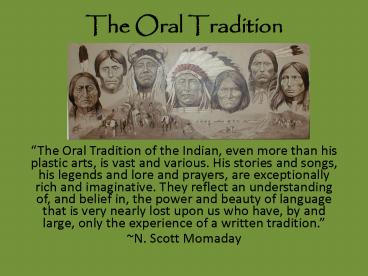The Oral Tradition - PowerPoint PPT Presentation
1 / 15
Title:
The Oral Tradition
Description:
His stories and songs, his legends and lore and prayers, are exceptionally ... oratory. chants. were not recognized by Western scholars until the late 1800s. ... – PowerPoint PPT presentation
Number of Views:1610
Avg rating:3.0/5.0
Title: The Oral Tradition
1
The Oral Tradition
- The Oral Tradition of the Indian, even more than
his plastic arts, is vast and various. His
stories and songs, his legends and lore and
prayers, are exceptionally rich and imaginative.
They reflect an understanding of, and belief in,
the power and beauty of language that is very
nearly lost upon us who have, by and large, only
the experience of a written tradition. - N. Scott Momaday
2
Misrepresentations
3
The First Migration Ice Age Travelers
- Archaeological evidence tells us that anywhere
from 20 to 40 thousand years ago, Ice Age
hunters traveling with dogs crossed the Bering
land bridge from Siberia to modern day Alaska. - Over centuries these people and their descendants
migrated and populated North and South America.
4
Way of Life
- The Native Americans did not think of themselves
as living in a single nation as we do today in
America. - Original native peoples belonged to more than 200
distinct groups who spoke more than 500
languages. - Their ways of life were dictated by their natural
surroundings. - They had complex religious beliefs, sophisticated
political systems, and strong social values (all
of these are reflected in their literature.)
5
Give Credit Where Credit Is Due
- American Indian oral literatures, including
- epic narratives
- poems
- songs
- oratory
- chants
- were not recognized by Western scholars until
the late 1800s. - Until then, it was assumed that
Native Americans had no literature!
6
Oral Traditions
- Oral traditions preserve historical continuity,
however they are responsive to change. - The American Indian world view is not that of a
progressive line, but an endless circle. - Cycles in Native American Literature
- cycle of existence- birth, death, rebirth
- changing seasons
- repeated ceremonies.
7
Native American Cultures Use Stories To
- Teach moral lessons and convey practical
information about the natural world. - Reflect a view of the natural world that is more
inclusive than that found in Western literature. - Show keen awareness of the power of metaphor.
8
Walum Olum
- A creation myth of the Delaware people.
- Means Painted Record and is a
chronicle of the beginning of the
world and the
origins of the Delaware people. - Walum Olum impact
- Delaware kept in touch with their past
- Found their identity in the framework of history
as they remembered it. - The ancient words also celebrated the Manito, the
supernatural force, or spirit, believed by the
Delaware to be the source of both good and evil. - This form of writing was not developed on the
phonetic representation of sounds, but on picture
writing.
9
Creation Myths
Myth stories that explain objects or events
in the natural world as a result of
action from a
supernatural force. Creation Myth traditional
story passed down
through generations, that explains
the creation of earth or phenomena in
it. Cause-and-effect relationship present
when one event directly brings
about the other
event. This relationship is
present in creation myths.
10
Grandmother Spider
- Popular character in Native American stories and
myths, but also seen in many other cultural
stories throughout world literature - Not a cartoon character, but a symbolic
character - Represents religious beliefs
- Represents nature
- Linked with rituals
11
Folk Tales
- Folk tales- stories handed down by word of mouth
from generation to generation. - Trickster tale- a type of folk tale that focuses
on an animal or human character who engages in
cheating, violence, and magic. - Characteristics of trickster tales
- 1) magical transformations
- 2) animals that act like humans
- 3) explanations of natural phenomena
12
Mourning Dove
- Mourning Dove was Christine
Quintaskets pen name. - Responsible for translating many folk tales,
- Among few capable of translating because she knew
various Native American languages and learned
English in Cathloic school. - Efforts helped preserve the oral tradition of by
translating stories to English
13
Coyote
- One of the most important characters
in Native American literature - He is thought to have made the world habitable
for humans by killing monsters, bringing fire,
and catching fish. - Coyote stories are told in many Native American
cultures across the western states.
14
The World on the Turtles Back
- What do the womans actions symbolize?
- Creation myths answer how things came to be. How
did creation begin according to this myth? - Why do you think the Iroquois honor both the
left-handed twin and the right-handed twin? - How does this myth compare with our earlier
accounts of creation in class? - How would you relate the left-handed and
right-handed twins to your own concept of good
and evil?
15
Legends
- Based on real events or characters
- Regarded as historical
- May contain elements that are difficult to prove
- One of the most popular genres found in he oral
tradition along with the myth.































